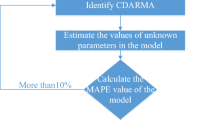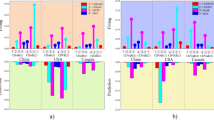Abstract
Structural prediction and analysis of sub-industrial energy consumption with economic data across three industrial sectors are an important basis for reflecting the coordinated development relationship between energy consumption and industrial development. Empirically, the sub-industrial energy consumption and economic structure have numerous compositional data. The multivariate compositional data’s fractional gray multivariate model on the basis of the Simplex space and its algebraic system is proposed in this study aiming at the multi-dimensional small sample size with high uncertainties. First, the fractional accumulative generation operation sequence of multivariate compositional data is defined according to Aitchison geometry. Then, the novel model with the form of the compositional data vector is obtained. Second, the least square parameter estimation of the model is studied. A derived model is deduced and selected as the time-response expression of the model solution. Moreover, the gray wolf optimizer is introduced and designed to determine the optimal value of the fractional order. Detailed modeling procedures, including the computational steps and the intelligent optimization algorithm, have been clearly presented. Furthermore, 10-year economic structural data of 14 provinces in China are used to validate the effectiveness of the proposed model. The validation presents that the proposed model performs better in fitting, prediction, stability, and applicability, in comparison with the two other models in the Simplex space. Last, from the updated real-time datasets from 2008 to 2018, the proposed model is applied to analyze and forecast the sub-industrial energy consumption structure and industrial structure of Beijing. Results show that the proposed model presents high accuracy and is efficient in addressing the multivariate compositional data in some structural energy and economic issues.






Similar content being viewed by others
References
Aitchison J (1982) The statistical analysis of compositional data. J R Stat Soc Ser B (Methodol) 44(2):139–160
Aitchison J, Barceló-Vidal C, Martín-Fernández JA et al (2000) Logratio analysis and compositional distance. Math Geol 32(3):271–275
Aitchison J (1983) Principal component analysis of compositional data. Biometrika 70(1):57–65
Aitchison J (1984) Reducing the dimensionality of compositional data sets. J Int Assoc Math Geol 16(6):617–635
Egozcue JJ, Pawlowsky-Glahn V, Mateu-Figueras G et al (2003) Isometric logratio transformations for compositional data analysis. Math Geol 35(3):279–300
Egozcue JJ, Pawlowsky-Glahn V (2005) Groups of parts and their balances in compositional data analysis. Math Geol 37(7):795–828
Engle MA, Rowan EL (2014) Geochemical evolution of produced waters from hydraulic fracturing of the Marcellus Shale, northern Appalachian Basin: a multivariate compositional data analysis approach. Int J Coal Geol 126:45–56
Wang H, Huang W, Liu Q (2003) Forecast analysis for Beijing’s industry structure. Syst Eng Theory Pract 06:123–126
Aitchison J, Ng KW (2005) The role of perturbation in compositional data analysis. Stat Modell 5(2):173–185
Aitchison J, Egozcue JJ (2005) Compositional data analysis: where are we and where should we be heading? Math Geol 37(7):829–850
Pawlowsky-Glahn V, Egozcue JJ (2001) Geometric approach to statistical analysis on the simplex. Stoch Env Res Risk Assess 15(5):384–398
Von Eynatten H, Pawlowsky-Glahn V, Egozcue JJ (2002) Understanding perturbation on the simplex: a simple method to better visualize and interpret compositional data in ternary diagrams. Math Geol 34(3):249–257
Egozcue JJ, Pawlowsky-Glahn V (2006) Simplicial geometry for compositional data. Geol Soc Lond Spec Publ 264(1):145–159
Fišerová E, Hron K (2010) Total least squares solution for compositional data using linear models. J Appl Stat 37(7):1137–1152
Parent LÉ (2011) Diagnosis of the nutrient compositional space of fruit crops. Revista Brasileira de Fruticultura 33(1):321–334
Wang H, Shangguan L, Wu J et al (2013) Multiple linear regression modeling for compositional data. Neurocomputing 122:490–500
Pawlowsky-Glahn V, Egozcue JJ (2016) Spatial analysis of compositional data: a historical review. J Geochem Explor 164:28–32
Wang H, Shangguan L, Guan R et al (2015) Principal component analysis for compositional data vectors. Comput Stat 30(4):1079–1096
Dumuid D, Stanford TE, Martin-Fernández JA et al (2018) Compositional data analysis for physical activity, sedentary time and sleep research. Stat Methods Med Res 27(12):3726–3738
Li Y (2019) Prediction of energy consumption: variable regression or time series? A case in China. Energy Sci Eng. https://doi.org/10.1002/ese3.439
Yuan P, Duanmu L, Wang Z (2019) Coal consumption prediction model of space heating with feature selection for rural residences in severe cold area in China. Sustain Cities Soc. https://doi.org/10.1016/j.scs.2019.101643
Pham A-D, Ngo N-T, Truong TTH, Huynh N-T, Truong N-S (2020) Predicting energy consumption in multiple buildings using machine learning for improving energy efficiency and sustainability. J Clean Prod. https://doi.org/10.1016/j.jclepro.2020.121082
Zeng A, Ho H, Yao Yu (2019) Prediction of building electricity usage using Gaussian process regression. J Build Eng. https://doi.org/10.1016/j.jobe.2019.101054
Hadri S, Naitmalek Y, Najib M, Bakhouya M, Fakhri Y, Elaroussi M (2019) A comparative study of predictive approaches for load forecasting in smart buildings. Proc Comput Sci. https://doi.org/10.1016/j.procs.2019.09.458
Kavaklioglu K (2010) Modeling and prediction of Turkey’s electricity consumption using support vector regression. Appl Energy. https://doi.org/10.1016/j.apenergy.2010.07.021
Amasyali K, El-Gohary N (2016) Building lighting energy consumption prediction for supporting energy data analytics. Proc Eng. https://doi.org/10.1016/j.proeng.2016.04.036
Bogner K, Pappenberger F, Zappa M (2019) Machine learning techniques for predicting the energy consumption/production and its uncertainties driven by meteorological observations and forecasts. Sustainability. https://doi.org/10.3390/su11123328
Touzani S, Granderson J, Fernandes S (2018) Gradient boosting machine for modeling the energy consumption of commercial buildings. Energy Build. https://doi.org/10.1016/j.enbuild.2017.11.039
Cao J, Liu L, Yang L et al (2020) Application of a novel fractional order grey support vector regression model to forecast wind energy consumption in China. J Adv Math Comput Sci 35(2):58–69
Zeng B, Li C (2016) Forecasting the natural gas demand in China using a self-adapting intelligent grey model. Energy 112:810–825
Peng Z, Xin Ma, Kun S (2019) A novel power-driven fractional accumulated grey model and its application in forecasting wind energy consumption of China. PLoS ONE. https://doi.org/10.1371/journal.pone.0225362
Xiao X, Mao S (2013) The method of grey prediction and decision. Science Press, Beijing, pp 272–299
Xie N, Wang R (2017) A historic review of grey forecasting models. J Grey Syst 29(4):1–30
Xiao X, Duan H (2020) A new grey model for traffic flow mechanics. Eng Appl Artif Intell. https://doi.org/10.1016/j.engappai.2019.103350
Zeng B, Duan H, Zhou Y (2019) A new multivariable grey prediction model with structure compatibility. Appl Math Model 75:385–397
Duan H, Xiao X, Xiao Q (2020) An inertia grey discrete model and its application in short-term traffic flow prediction and state determination. Neural Comput Appl 32(12):8617–8633
Ren J (2018) GM(1, N) method for the prediction of anaerobic digestion system and sensitivity analysis of influential factors. Biores Technol 247:1258–1261
Guo M, Lan J, Li J et al (2011) Traffic flow data recovery algorithm based on gray residual GM(1, N) model. J Transp Syst Eng Inf Technol 12(1):42–47
Wang Z (2015) Multivariable time-delayed GM(1, N) model and its application. Control Decis 30(12):2298–2304
Xie N, Liu S (2009) Discrete grey forecasting model and its optimization. Appl Math Model 33(2):1173–1186
Xie N, Liu S, Yang Y et al (2013) On novel grey forecasting model based on nonhomogeneous index sequence. Appl Math Model 37(7):5059–5068
Ma X, Liu Z (2016) Research on the novel recursive discrete multivariate grey prediction model and its applications. Appl Math Model 40(7–8):4876–4890
Wu L, Liu S, Yao L et al (2013) Grey system model with the fractional order accumulation. Commun Nonlinear Sci Numer Simul 18(7):1775–1785
Mao S, Gao M, Xiao X (2015) Fractional order accumulation time-lag GM(1, N, τ) model and its application. Syst Eng Theory Pract 35(02):430–436
Wu W, Ma X, Wang Y et al (2019) Research on a novel fractional GM (α, n) model and its applications. Grey Syst Theory Appl 9(3):356–373
Pawlowsky-Glahn V, Egozcue JJ (2006) Compositional data and their analysis: an introduction. Geol Soc Lond Spec Publ 264(1):1–10
Kynčlová P, Filzmoser P, Hron K (2015) Modeling compositional time series with vector autoregressive models. J Forecast 34(4):303–314
Grifoll M, Ortego MI, Egozcue JJ (2019) Compositional data techniques for the analysis of the container traffic share in a multi-port region. Eur Transp Res Rev. https://doi.org/10.1186/s12544-019-0350-z
Egozcue JJ, Daunis-i-Estadella J, Pawlowsky-Glahn V, Hron K, Filzmoser P (2012) Simplicial regression. The normal model. J Appl Probab Stat 6(1&2):87–108
Monti G, Mateu-Figueras G, Pawlowsky-Glahn V et al (2015) Shifted-Dirichlet regression versus simplicial regression: a comparison. Welcome to CoDawork, pp 76–83
Zhou W, Fang Z (2010) Nonlinear optimization method of gray GM(1, N) model and application. Syst Eng Electron 32(02):317–320
Xie N, Liu S (2006) Research on extension of discrete grey model and its optimize formula. Syst Eng Theory Pract 26(6):108–112
Mirjalili S, Mirjalili SM, Lewis A (2014) Grey wolf optimizer. Adv Eng Softw 69:46–61
Mirjalili S (2015) How effective is the Grey Wolf optimizer in training multi-layer perceptrons. Appl Intell 43(1):150–161
Jayabarathi T, Raghunathan T, Adarsh BR et al (2016) Economic dispatch using hybrid grey wolf optimizer. Energy 111:630–641
Mohanty S, Subudhi B, Ray PK (2015) A new MPPT design using grey wolf optimization technique for photovoltaic system under partial shading conditions. IEEE Trans Sustain Energy 7(1):181–188
Jiang T, Zhang C (2018) Application of grey wolf optimization for solving combinatorial problems: job shop and flexible job shop scheduling cases. IEEE Access 6:26231–26240
Ma X, Wu W, Zeng B, Wang Y, Wu X (2019) The conformable fractional grey system model. ISA Trans. https://doi.org/10.1016/j.isatra.2019.07.009
China Statistical Yearbook (2009–2018) National Bureau of statistics. http://www.stats.gov.cn/tjsj/ndsj/
Statistical Communique on the National Economy and Social Development of Beijing (2019) Beijing municipal Bureau of statistics. http://tjj.beijing.gov.cn/tjsj/tjgb/ndgb/201903/t20190319_171508.html
Bacon-Shone J (1992) Ranking methods for compositional data. J R Stat Soc Ser C (Appl Stat) 41(3):533–537
Martín-Fernández JA, Barceló-Vidal C, Pawlowsky-Glahn V (2003) Dealing with zeros and missing values in compositional data sets using nonparametric imputation. Math Geol 35(3):253–278
Zhou W, Zhang D (2016) An improved metabolism grey model for predicting small samples with a singular datum and its application to sulfur dioxide emissions in China. Discrete Dyn Nat Soc. https://doi.org/10.1155/2016/1045057
Acknowledgements
The authors are grateful to the editor for their valuable comments. This research is supported by the National Natural Science Foundation of China (71871174, 61403288) and the Fundamental Research Funds for the Central Universities (WUT: 2019IA005).
Author information
Authors and Affiliations
Corresponding author
Ethics declarations
Conflict of interest
The authors declare that they have no conflict of interest.
Additional information
Publisher's Note
Springer Nature remains neutral with regard to jurisdictional claims in published maps and institutional affiliations.
Appendix
Rights and permissions
About this article
Cite this article
Chen, H., Xiao, X. & Wen, J. Novel multivariate compositional data’s model for structurally analyzing sub-industrial energy consumption with economic data. Neural Comput & Applic 33, 3713–3735 (2021). https://doi.org/10.1007/s00521-020-05227-5
Received:
Accepted:
Published:
Issue Date:
DOI: https://doi.org/10.1007/s00521-020-05227-5




